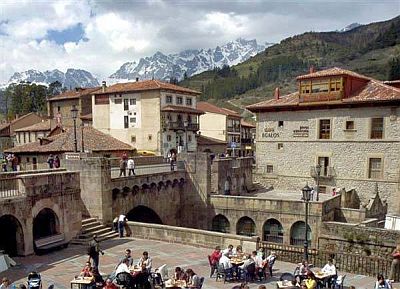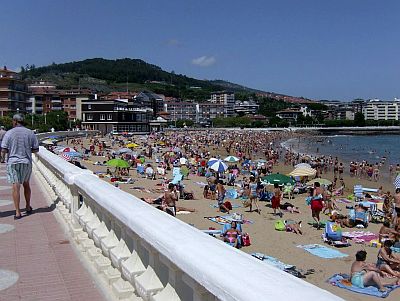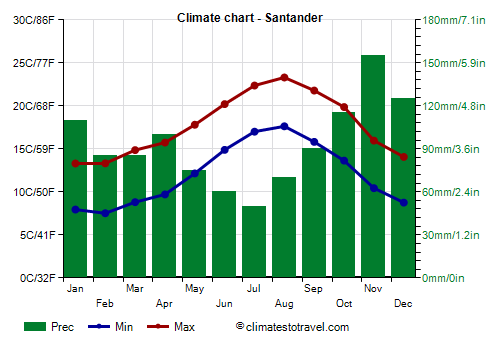Select units of measurement for the temperature and rainfall tables (metric or imperial).
Average weather, temperature, rainfall, sunshine hours
Index
Introduction
In the autonomous community of Cantabria, corresponding to the province of Santander and located in northern Spain, the climate is
cool and damp on the coast because of the influence of the Atlantic Ocean, while in inland areas, it becomes colder with increasing altitude, and more continental in the south. On the coast (called "
la Marina"), winters are mild and rainy, and summers are cool and fairly sunny. Atlantic frontal systems can affect this area all year round, though they become rarer in summer, when, however, drizzle and short showers may occur.
The
wind blows frequently, in fact, there are several beaches frequented by surfers.
Fog is common as well: it can present itself all year round, when there is no wind, and on summer nights too, especially along the coast and in the valleys.
Precipitation is quite abundant in much of the territory, in fact, it hovers around 1,000/1,200 millimeters (40 to 47 inches) per year on the coast, while it can exceed 2,000 mm (79 in) in the hills of the north-central and in the mountains, so much so that the landscape is green. Only in the southern part (in the
comarca of Campoo-Los Valles, see Reinosa, Valderredible) and in some sheltered valleys (Valley of Liébana, see Potes), precipitation ranges from 700 mm (27.5 in) to 850 mm (33.5 in). Summer is the least rainy season everywhere.
In
winter, cold air masses from the northeast can bring cold and windy periods, but on the coast, very cold days are rare (the cold records are a few degrees below freezing). However, even on mild days, the wind can increase the feeling of cold.
Snow, very rare on the coast, is a bit more frequent in inland hilly areas, while in the mountainous peaks, heavy snowfalls can occur. On the coast, frosts are rare as well, and in any case, they are light, while they are more frequent, and at times can be intense, in the interior.
In
summer, temperatures are cool along the coast and in inland mountainous areas. In the south, although there are no plains, hot days are more frequent even at 600/700 meters (2,000/2,300 feet) above sea level, with highs around 30 °C (86 °F) or more, since this zone is close to the
meseta, the spanish arid plateau. In summer, when high pressure systems are more common, there are many sunny days in the mountains and in the south of the region, where thunderstorms can break out in the afternoon or evening. Instead, along the coast, fog can form at night and in the early morning, moreover, a cloudy layer often forms due to the cold sea, which brings a kind of drizzle, called
morrina, especially in late spring and early summer.
Spring and autumn are unstable seasons, characterized by the passage of fronts that bring clouds and rain (and snow in the mountains), but also by sudden increases in temperature when the wind blows from the south, and by rapid cooling when cold air masses arrive from the North Atlantic.

In the
interior, we find hills, and in the southern part also a mountain range, the
Cantabrian Mountains, which separate this cool and moist part of Spain from the arid
meseta; in particular, in the western part, we find the "Peaks of Europe" (
Picos de Europa), shared by Cantabria with the region of
Asturias.
The highest peak in Cantabria is Torre Blanca, 2,618 meters (8,591 feet) high and located on the border with Asturias, while the Peña Vieja, 2,617 meters (8,586 ft) high, is located entirely in the Cantabrian territory.
The wind descending from the mountains can cause rapid increases in temperature due to the
föhn effect: in these cases, along the coast, the temperature may exceed 20 °C (68 °F) in winter, 30 °C (86 °F) in autumn and spring, and 35 °C (95 °F) in summer, when, however, this wind is rare.

On the
coast, there are bays and inlets, such as the Bay of Santander, and the lagoons of the
Parque Natural de las Marismas de Santoña, Victoria y Joyel.
About ten kilometers (6 miles) away from the coast, we find the
Secuoyas del Monte Cabezón National Park, where a forest of
Sequoia sempervirens grows, while a few kilometers (or miles) away from the coast, we find the
Cave of Altamira, famous for its cave paintings of the Paleolithic, and a UNESCO World Heritage Site.
In Cantabria, the
Ebro river has its source, in
Pico Tres Mares, a mountain of 2,173 meters (7,129 feet); on the outskirts of Reinosa, the river widens into an artificial reservoir called
embalse del Ebro, at 800 meters (2,600 feet) above sea level.
Santander

In the capital,
Santander, located on the coast, the monthly average temperature ranges from 10.5 °C (51 °F) in January and February to 20.5 °C (69 °F) in August. The daily temperature variation is generally reduced because of the influence of the ocean. In summer, a season that has often the taste of spring, the temperature reaches or exceeds 30 °C (86 °F) very rarely: it might not happen for a whole summer month. The lowest recorded temperatures are around -5 °C (23 °F) and the highest around 37/38 °C (99/100 °F).
Here are the average temperatures.
Santander - Average temperatures (1991-2020) |
| Month | Min | Max | Mean |
|---|
| January | 8 | 13.3 | 10.6 |
|---|
| February | 7.5 | 13.3 | 10.4 |
|---|
| March | 8.8 | 14.9 | 11.8 |
|---|
| April | 9.7 | 15.7 | 12.7 |
|---|
| May | 12.2 | 17.8 | 15 |
|---|
| June | 14.9 | 20.2 | 17.6 |
|---|
| July | 17 | 22.4 | 19.7 |
|---|
| August | 17.6 | 23.3 | 20.5 |
|---|
| September | 15.8 | 21.8 | 18.8 |
|---|
| October | 13.6 | 19.9 | 16.8 |
|---|
| November | 10.4 | 16 | 13.2 |
|---|
| December | 8.8 | 14.1 | 11.4 |
|---|
| Year | 12.1 | 17.7 | 14.85 |
|---|
Santander gets an average of 1.115 mm (44 in) of rain per year, with a maximum in autumn and winter and a minimum in summer, when, however, it still rains for 8/9 days per month.
Santander - Average precipitation| Month | Days |
|---|
| January | 110 | 13 |
|---|
| February | 85 | 11 |
|---|
| March | 85 | 10 |
|---|
| April | 100 | 12 |
|---|
| May | 75 | 11 |
|---|
| June | 60 | 9 |
|---|
| July | 50 | 8 |
|---|
| August | 70 | 9 |
|---|
| September | 90 | 10 |
|---|
| October | 115 | 12 |
|---|
| November | 155 | 10 |
|---|
| December | 125 | 13 |
|---|
| Year | 1115 | 127 |
|---|
The amount of
sunshine in Cantabria is not very good, especially in the central-northern part. In July and August, there are 6 hours of sunshine per day along the coast and in Santander; in the other seasons, and especially in late autumn and winter, it goes even worse, and the sky is often cloudy.
Santander - Sunshine hours| Month | Average | Total |
|---|
| January | 2.5 | 85 |
|---|
| February | 3.5 | 105 |
|---|
| March | 4.5 | 135 |
|---|
| April | 5 | 150 |
|---|
| May | 5.5 | 170 |
|---|
| June | 6 | 180 |
|---|
| July | 6 | 185 |
|---|
| August | 6 | 180 |
|---|
| September | 5.5 | 160 |
|---|
| October | 4 | 130 |
|---|
| November | 3 | 95 |
|---|
| December | 2.5 | 75 |
|---|
| Year | 4.5 | 1645 |
|---|
The
sea along the coast of Cantabria is very cool even in summer, since it reaches 20 degrees (68 °F) in July and 21 °C (70 °F) in August.
Santander - Sea temperature| Month |
|---|
| January | 13 |
|---|
| February | 12 |
|---|
| March | 13 |
|---|
| April | 13 |
|---|
| May | 15 |
|---|
| June | 17 |
|---|
| July | 20 |
|---|
| August | 21 |
|---|
| September | 20 |
|---|
| October | 18 |
|---|
| November | 15"> |
|---|
| December | 14 |
|---|
| Year | 16 |
|---|
Best Time
The
best time to visit Cantabria is the summer, from June to August or the first half of September, since it is the driest and sunniest of the year. July and August are the warmest and least rainy months. Even in midsummer, we must take into account some rain, and some nights a little cool on the coast, and a bit cold in inland areas.
In summer, in good weather, you can take a break at the beach and sunbathe, with an air temperature often pleasant and a cool breeze from the ocean, although, as I said, the sea is a bit cold for swimming.
Back to top